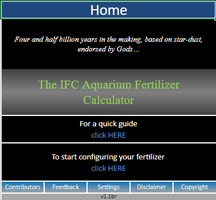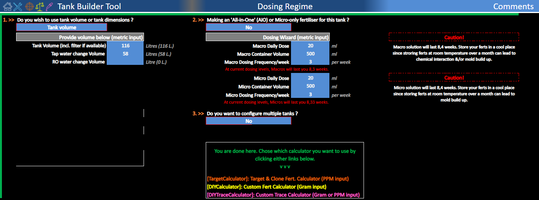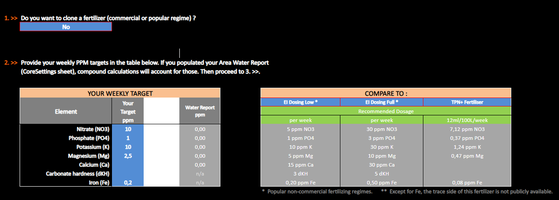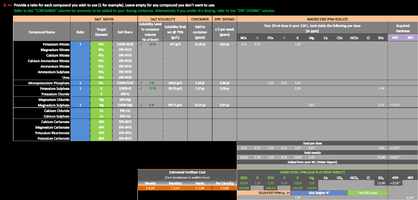I was approached by @swyftfeet for some help with the IFC calculator.
The calculator is not really intended for the newest newbies, but if you know what you have in mind for a fertilizer, or have been told by someone what you need, you may be able to get by
This little tutorial aims to be a short guide for those who are stuck on a few of the concepts, using Swyftfeet's setup as our example.
The latest version of the IFC calculator can be found HERE.
Make sure you click on and read the tab "Spoiler: Technical notes" first!
The download is in the tab "Spoiler: Download".
The calculator is intended to be run in the program Excel.
If you do not have Excel, you can find details HERE on how to run the IFC calculator file using Microsoft OneDrive.
Once you have the file opened in Excel or OneDrive, you will be greeted by the Home Screen

Click to read the quick guide, press the "Back Home" button in the top left, and then click to start configuring your fertilizer.

You will be greeted by a mostly black screen. Start filling out the blue areas with your information. More blue areas will open up as you proceed.

Tank Builder Tool + Dosing Regime
Step 1. We're gonna go with tank volume. In Swyftfeet's case around 116 liters. If you have one or more large external canister filters you can factor this into the tank volume.
Same for large amounts of substrate, but keep in mind there is still some water inside substrate.
We're gonna go for a water change volume that is half of our tank volume, this fits with a standard 50% water change.
We're not changing with any RO water so we will leave this field empty.
Step 2. We're not making an all in one in this case, we want to make separate macro and micro solutions.
Play with the ml amounts of the dose and container volume. In most cases it's better to make a slightly dilute fertilizer than a very concentrated one.
If you have an autodoser set up to dose daily, enter a frequency of 7 per week. In our case we are dosing manually with macros and micros every other day with no dose on water change day, meaning our frequency should be 3.
We have already purchased some 500 ml containers, so 20 ml will be a suitable dose, making the total solution last about two months.
The calculator will automatically tell you how long your solution will last. 2-3 months is a pretty common target, you shouldnt run into mold issues with this length as long as your containers are relatively clean.
If it is your first time mixing ferts it can be wise not to make something that lasts much longer than this.
You might run into problems during mixing or discover in three weeks that you want to change something. Making smaller batches at first will waste less salts.
Step 3. We only want to configure one tank, so we will select no. Now we are done on this page.
We're going to use the Target Calculator since we have some PPM targets already in mind, to make fertilizer that is around 1/3 of EI.
(I advise all newbies to stay away from the DIY Trace Calculator until you're really really familiar with ferts. The potential for things to go wrong is much higher as traces are toxic in anything other than very small amounts.)
Click Target Calculator to proceed to the next section.

Target Calculator
The calculator will have already filled out this first section for you. Take note of the right-hand section. The calculator tells you how much preservatives should be added to the container volume you have.
I recommend you use RO/DI water or deionized/demineralized water. I use demineralized water, I find it in car supply shops sold as refill water for car batteries.
I personally dont mix my fertilizer solution directly into the container, but use a clean measuring jug used only for ferts.
When we pour in the amount of water needed to make the fertilizer, we should take into account that salts are going to be added to it and increasing the volume.
The total/final volume, which in our example is 500 ml, is what we want to have at the end of the fertilizer making process.
Since we dont know exactly how much our salt additions will make the water level increase in the jug, its easiest to first pour in a little less than the final volume of fertilizer.
For example, in our case we could pour around 450 ml of the pure water into the measuring jug, add the salts, and then top up the measuring jug with a bit more pure water, so that the final volume measures exactly 500 ml.
We will do that two times, one for our macro mix and one for our micro mix, since we are making two fertilizers.
Go ahead and first add the ascorbic acid and potassium sorbate. The ascorbic acid lowers the PH of your fert solution, keeping some things from precipitating out.
Potassium sorbate slows mold growth and has a synergistic effect with ascorbic acid.
Some people use white vinegar instead of ascorbic acid. The amount of white vinegar required varies depending on the strength(%) of the vinegar and the kind of salts used in the fertilizer.
I have used 2 ml of 35% white vinegar for 1000 ml of chelated micro fertilizer, but was able to use much less for macro fertilizer.

Step 1. We're not making a clone in our case, we want to input the PPM targets ourselves, so we select no.
Step 2. This step is difficult if you dont know precisely what you want. If you press the blue boxes on the right hand side you can select many different popular fertilizers to compare numbers to.
Swyftfeet has a non CO2-injected tank, so in this particular case we're going to go for a version that is about 1/3 of EI dosing. EI stands for Estimative Index by the way. 1/3 for his tank should be plenty.
So we put in 10, 1 and 10 for NO3, PO4 and K.
You want to make sure your plants are also supplied with both Calcium and Magnesium. If you have hard water (high GH) you will most likely have all the Calcium you need. Check your local water supply report to find out. If you have soft water you may want to add some Ca and Mg though. Its not a good idea to add Calcium to our macro mix or our micro mix, because the Calcium does not play nice and it binds with the other nutrients, causing them to be unavailable to the plants. So if your situation calls for Calcium, it is better to add it to your water change water as a dry powder. Most also add some dry Magnesium this way. Because Magnesium is often in shorter supply than Calcium, in our case we are going to add a little bit of it to the macros. This is optional and just to make sure there is absolutely no risk of running out. Swyftfeet's tap water contains decent amounts of both Calcium and Magnesium, so we put in just 2,5 ppm. We're not looking to raise our Carbonate hardness, so we leave this blank. Finally we settle for around 0,2 ppm Iron.

Step 3. The ratio it is talking about here in the blue column pertains to if we want to use multiple different salts to contribute to the same kind of nutrient.
Lets take K for instance, when it asks us for a ratio, it wants to know if we want to use both Potassium Sulphate AND Potassium Chloride to give us Potassium (K).
If we wanted to use an equal (50/50) split of Potassium Sulphate and Potassium Chloride, we would put the number 1 into both of those sections.
If we wanted to use 2 parts Potassium Sulphate to 1 part Potassium Chloride, we would put the number 2 into the former box and the number 1 into the latter box. Thats a 2:1 ratio, in other words.
We are not looking to do this here though, so we are just going to put the number 1 next to the names of the salts we have on hand, since we want to keep things simple. We have Potassium Nitrate (KNO3) for NO3, Monopotassium Phosphate (KH2PO4) for PO4, Potassium Sulphate (K2SO4) for K and Magnesium Sulphate (MgSO4 / Epsom salt) for Mg. You can use other salts but these are the standard choices. Particularly for sources of NO3 you should stick to the standard unless you are an advanced user.
As you fill out the blue boxes the calculator gives more information on the right hand side.
If you look at the column that says "Solubility Level", it tells us how much "room" we have in our water for our salts. We can only dissolve so and so much salt into water before the water becomes "full", and if we try to add more, the salts will just sit on the bottom of our container. We are only using a small percentage of our solubility level, so we are good here.
Under "Container", the calculator says how much of each salt to add to our prepared water.
Add each salt one at a time, be sure to weigh it out using an accurate scale.
Stir well between each salt so that you see the powder/crystals have dissolved completely.
Your end solution should not turn milky or opaque, but be totally clear.
You are now done with your macro fertilizer

Last section; micros. Swyftfeet has purchased a premade trace blend from NilocG, so we select that one in the first blue box. The other two blue boxes are in case we want to add an additional source of Fe (Iron).
Swyftfeet's tap water has a PH of around 7.8. Many trace blends contain iron chelated with EDTA. You can see in the graph attached to this post that EDTA is best for slightly lower PH than what Swyftfeet has.
So we are going to add a little bit of Fe DTPA, which stays available to the plants at a slightly higher PH.
This time we are going to use the Ratio feature. In our case we want to have a ratio of 2:1 of the CSM+B vs Fe DTPA. The kind Swyftfeet has purchased is 11% Fe DTPA, so we select that in the drop down menu. Make sure you get the percentage that matches your particular salt. We can see under the column "Salt Share" that this 2:1 ratio will give us 67% Fe and traces, and 33% of Fe DTPA. We dont want to use 100% Fe DTPA, because then we wont get any of the other traces from the trace blend.
Add the amounts listed in the "Container" column to your second batch of prepared water (not the macro solution!) and stir well.
The solution should not turn milky or opaque, but be a transparent colored liquid, usually some kind of yellow/brown, or reddish if you use Fe EDDHA.
You're all done!
Pat yourself on the back, you just saved yourself a ton of money

Let me know if you have questions or any suggestions for changes to this little guide Please especially let me know if you spot any mistakes or parts you disagree with.
Please especially let me know if you spot any mistakes or parts you disagree with.
It is not meant to cover every case but the questions I have seen most commonly asked 😊
The calculator is not really intended for the newest newbies, but if you know what you have in mind for a fertilizer, or have been told by someone what you need, you may be able to get by
This little tutorial aims to be a short guide for those who are stuck on a few of the concepts, using Swyftfeet's setup as our example.
The latest version of the IFC calculator can be found HERE.
Make sure you click on and read the tab "Spoiler: Technical notes" first!
The download is in the tab "Spoiler: Download".
The calculator is intended to be run in the program Excel.
If you do not have Excel, you can find details HERE on how to run the IFC calculator file using Microsoft OneDrive.
Once you have the file opened in Excel or OneDrive, you will be greeted by the Home Screen

Click to read the quick guide, press the "Back Home" button in the top left, and then click to start configuring your fertilizer.

You will be greeted by a mostly black screen. Start filling out the blue areas with your information. More blue areas will open up as you proceed.

Tank Builder Tool + Dosing Regime
Step 1. We're gonna go with tank volume. In Swyftfeet's case around 116 liters. If you have one or more large external canister filters you can factor this into the tank volume.
Same for large amounts of substrate, but keep in mind there is still some water inside substrate.
We're gonna go for a water change volume that is half of our tank volume, this fits with a standard 50% water change.
We're not changing with any RO water so we will leave this field empty.
Step 2. We're not making an all in one in this case, we want to make separate macro and micro solutions.
Play with the ml amounts of the dose and container volume. In most cases it's better to make a slightly dilute fertilizer than a very concentrated one.
If you have an autodoser set up to dose daily, enter a frequency of 7 per week. In our case we are dosing manually with macros and micros every other day with no dose on water change day, meaning our frequency should be 3.
We have already purchased some 500 ml containers, so 20 ml will be a suitable dose, making the total solution last about two months.
The calculator will automatically tell you how long your solution will last. 2-3 months is a pretty common target, you shouldnt run into mold issues with this length as long as your containers are relatively clean.
If it is your first time mixing ferts it can be wise not to make something that lasts much longer than this.
You might run into problems during mixing or discover in three weeks that you want to change something. Making smaller batches at first will waste less salts.
Step 3. We only want to configure one tank, so we will select no. Now we are done on this page.
We're going to use the Target Calculator since we have some PPM targets already in mind, to make fertilizer that is around 1/3 of EI.
(I advise all newbies to stay away from the DIY Trace Calculator until you're really really familiar with ferts. The potential for things to go wrong is much higher as traces are toxic in anything other than very small amounts.)
Click Target Calculator to proceed to the next section.

Target Calculator
The calculator will have already filled out this first section for you. Take note of the right-hand section. The calculator tells you how much preservatives should be added to the container volume you have.
I recommend you use RO/DI water or deionized/demineralized water. I use demineralized water, I find it in car supply shops sold as refill water for car batteries.
I personally dont mix my fertilizer solution directly into the container, but use a clean measuring jug used only for ferts.
When we pour in the amount of water needed to make the fertilizer, we should take into account that salts are going to be added to it and increasing the volume.
The total/final volume, which in our example is 500 ml, is what we want to have at the end of the fertilizer making process.
Since we dont know exactly how much our salt additions will make the water level increase in the jug, its easiest to first pour in a little less than the final volume of fertilizer.
For example, in our case we could pour around 450 ml of the pure water into the measuring jug, add the salts, and then top up the measuring jug with a bit more pure water, so that the final volume measures exactly 500 ml.
We will do that two times, one for our macro mix and one for our micro mix, since we are making two fertilizers.
Go ahead and first add the ascorbic acid and potassium sorbate. The ascorbic acid lowers the PH of your fert solution, keeping some things from precipitating out.
Potassium sorbate slows mold growth and has a synergistic effect with ascorbic acid.
Some people use white vinegar instead of ascorbic acid. The amount of white vinegar required varies depending on the strength(%) of the vinegar and the kind of salts used in the fertilizer.
I have used 2 ml of 35% white vinegar for 1000 ml of chelated micro fertilizer, but was able to use much less for macro fertilizer.

Step 1. We're not making a clone in our case, we want to input the PPM targets ourselves, so we select no.
Step 2. This step is difficult if you dont know precisely what you want. If you press the blue boxes on the right hand side you can select many different popular fertilizers to compare numbers to.
Swyftfeet has a non CO2-injected tank, so in this particular case we're going to go for a version that is about 1/3 of EI dosing. EI stands for Estimative Index by the way. 1/3 for his tank should be plenty.
So we put in 10, 1 and 10 for NO3, PO4 and K.
You want to make sure your plants are also supplied with both Calcium and Magnesium. If you have hard water (high GH) you will most likely have all the Calcium you need. Check your local water supply report to find out. If you have soft water you may want to add some Ca and Mg though. Its not a good idea to add Calcium to our macro mix or our micro mix, because the Calcium does not play nice and it binds with the other nutrients, causing them to be unavailable to the plants. So if your situation calls for Calcium, it is better to add it to your water change water as a dry powder. Most also add some dry Magnesium this way. Because Magnesium is often in shorter supply than Calcium, in our case we are going to add a little bit of it to the macros. This is optional and just to make sure there is absolutely no risk of running out. Swyftfeet's tap water contains decent amounts of both Calcium and Magnesium, so we put in just 2,5 ppm. We're not looking to raise our Carbonate hardness, so we leave this blank. Finally we settle for around 0,2 ppm Iron.

Step 3. The ratio it is talking about here in the blue column pertains to if we want to use multiple different salts to contribute to the same kind of nutrient.
Lets take K for instance, when it asks us for a ratio, it wants to know if we want to use both Potassium Sulphate AND Potassium Chloride to give us Potassium (K).
If we wanted to use an equal (50/50) split of Potassium Sulphate and Potassium Chloride, we would put the number 1 into both of those sections.
If we wanted to use 2 parts Potassium Sulphate to 1 part Potassium Chloride, we would put the number 2 into the former box and the number 1 into the latter box. Thats a 2:1 ratio, in other words.
We are not looking to do this here though, so we are just going to put the number 1 next to the names of the salts we have on hand, since we want to keep things simple. We have Potassium Nitrate (KNO3) for NO3, Monopotassium Phosphate (KH2PO4) for PO4, Potassium Sulphate (K2SO4) for K and Magnesium Sulphate (MgSO4 / Epsom salt) for Mg. You can use other salts but these are the standard choices. Particularly for sources of NO3 you should stick to the standard unless you are an advanced user.
As you fill out the blue boxes the calculator gives more information on the right hand side.
If you look at the column that says "Solubility Level", it tells us how much "room" we have in our water for our salts. We can only dissolve so and so much salt into water before the water becomes "full", and if we try to add more, the salts will just sit on the bottom of our container. We are only using a small percentage of our solubility level, so we are good here.
Under "Container", the calculator says how much of each salt to add to our prepared water.
Add each salt one at a time, be sure to weigh it out using an accurate scale.
Stir well between each salt so that you see the powder/crystals have dissolved completely.
Your end solution should not turn milky or opaque, but be totally clear.
You are now done with your macro fertilizer

Last section; micros. Swyftfeet has purchased a premade trace blend from NilocG, so we select that one in the first blue box. The other two blue boxes are in case we want to add an additional source of Fe (Iron).
Swyftfeet's tap water has a PH of around 7.8. Many trace blends contain iron chelated with EDTA. You can see in the graph attached to this post that EDTA is best for slightly lower PH than what Swyftfeet has.
So we are going to add a little bit of Fe DTPA, which stays available to the plants at a slightly higher PH.
This time we are going to use the Ratio feature. In our case we want to have a ratio of 2:1 of the CSM+B vs Fe DTPA. The kind Swyftfeet has purchased is 11% Fe DTPA, so we select that in the drop down menu. Make sure you get the percentage that matches your particular salt. We can see under the column "Salt Share" that this 2:1 ratio will give us 67% Fe and traces, and 33% of Fe DTPA. We dont want to use 100% Fe DTPA, because then we wont get any of the other traces from the trace blend.
Add the amounts listed in the "Container" column to your second batch of prepared water (not the macro solution!) and stir well.
The solution should not turn milky or opaque, but be a transparent colored liquid, usually some kind of yellow/brown, or reddish if you use Fe EDDHA.
You're all done!
Pat yourself on the back, you just saved yourself a ton of money
Let me know if you have questions or any suggestions for changes to this little guide
It is not meant to cover every case but the questions I have seen most commonly asked 😊
Attachments
Last edited:



